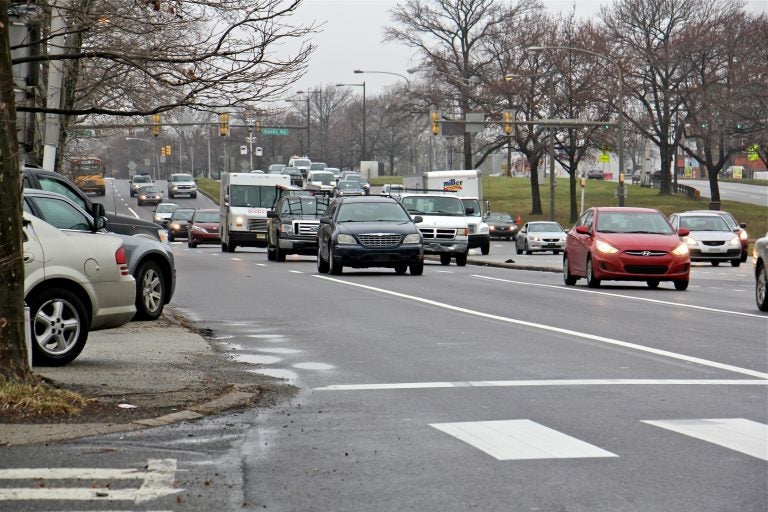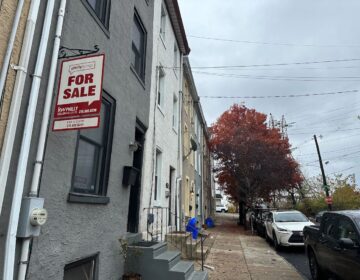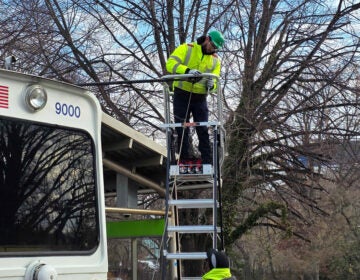Can we afford the Roosevelt Blvd. subway? Maybe now is the time
The idea of a speedy trip from Northeast Philly to City Hall has been suggested for decades. It should be part of the new infrastructure funding.

Traffic heads north on Roosevelt Boulevard near East Front Street. (Emma Lee/WHYY)
In 2003, six engineering, consulting, and design firms submitted a study to the Philadelphia City Planning Commission and SEPTA detailing the potential for rapid transit on Roosevelt Boulevard in Northeast Philadelphia. The Roosevelt Boulevard Corridor Study looked at multiple modes of rapid transit including light rail, bus rapid transit, and a heavy rail/subway line directly connected to the Broad Street Subway’s express tracks north of Erie Station.
The study found a Broad Street Subway extension along Roosevelt Boulevard and a one-mile extension of the Market-Frankford Line from Frankford Transportation Center to a new underground interchange between the lines at Bustleton Avenue and Roosevelt Boulevard would take under a decade to complete.
The subway was designed to offer six-minute peak headways and 12-minute off-peak headways along Roosevelt Boulevard and would complete the trip between the Far Northeast and City Hall in just 32 minutes. The line would have taken 83,300 cars off the road and had a daily ridership of 124,500, comparable to the patronage on SEPTA’s two other heavy rail lines.
There are few heavy rail projects of this magnitude anywhere else in the nation. The closest comparison would be the Purple Line extension that will connect downtown Los Angeles to Westwood — the full extension will attract nearly 50,000 weekday riders. When built, the Second Avenue Subway Phase 2 on the east side of Manhattan will serve 100,000 new riders daily. In San Jose, VTA’s BART Silicon Valley Phase II will carry 54,600 passengers each weekday. With an estimated 124,500 riders, the Roosevelt Boulevard Subway would have a higher daily use than any proposed subway in the Federal Transit Administration’s capital investment grants (CIG) program.
Unfortunately, even with these impressive ridership numbers, the subway was not built, not because of community opposition from northeast residents but because of a complicated funding situation with the Federal Transit Administration (FTA) during the Bush Administration.
The Roosevelt Boulevard subway was estimated to cost between $2.5 and $3.4 billion in 2000. To obtain federal funding from the FTA, the City of Philadelphia and the State of Pennsylvania needed a local match of 50%; it was not fiscally possible.
Spending $1.7 billion is a great deal of money in a city with diverse transit needs like Philadelphia. Hence, policymakers and planners explored other transit alternatives for the corridor, like enhancing bus service.
The failure to build the subway started a nearly decade-long period where the corridor was studied multiple times, but none of the studies included building a subway.
In 2011, the city’s 2035 Citywide Vision reviewed the subway line but recommended further study to identify transit alternatives. At the time, funding for heavy rail projects was simply not there.
In May 2016, the Delaware Valley Regional Planning Commission released a report which considered less expensive alternatives to the subway, mainly bus rapid transit. Most recently, in May 2021, the City of Philadelphia, SEPTA and PennDOT released the Final report for Route for Change, which seems to have abandoned the idea of a subway entirely for an underground expressway.
The Roosevelt Boulevard subway was not built nearly two decades ago because of a lack of funding, but today billions of dollars in federal financing exist for transportation projects from the bipartisan infrastructure law and the RAISE discretionary grant program.
The Biden Administration’s FTA could be more amenable to funding an infrastructure project that would create jobs, encourage transit-oriented development, and end a significant transit inequity. This combination of federal dollars and infrastructure grants makes now the perfect time to build the Roosevelt Boulevard subway once and for all.
Jay Arzu is a doctoral student of City and Regional Planning at the University of Pennsylvania Stuart Weitzman School of Design.

Subscribe to PlanPhilly
WHYY is your source for fact-based, in-depth journalism and information. As a nonprofit organization, we rely on financial support from readers like you. Please give today.









